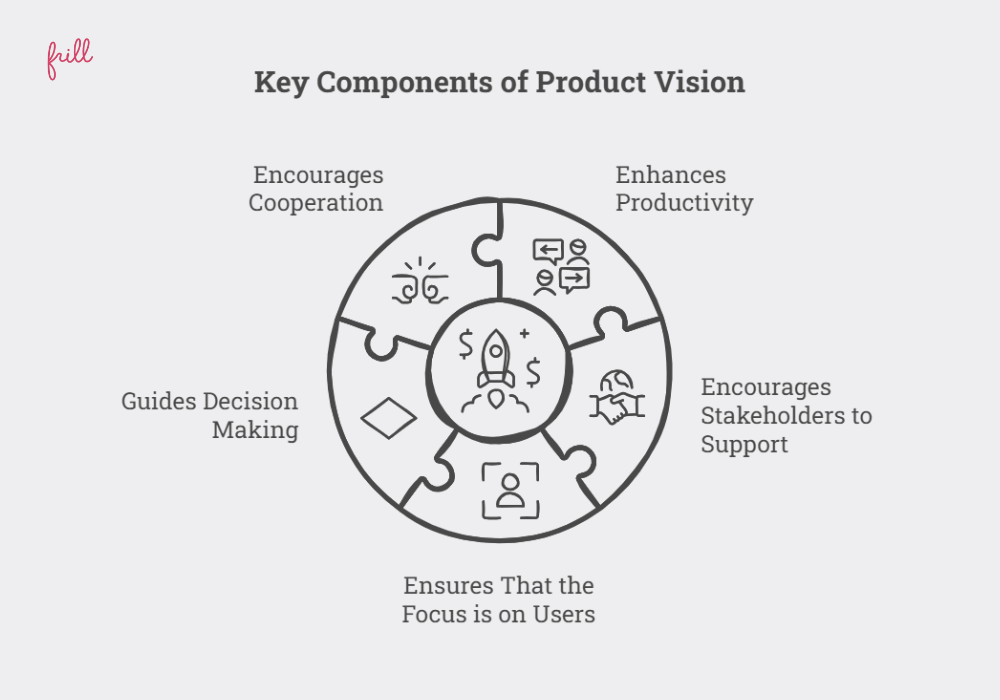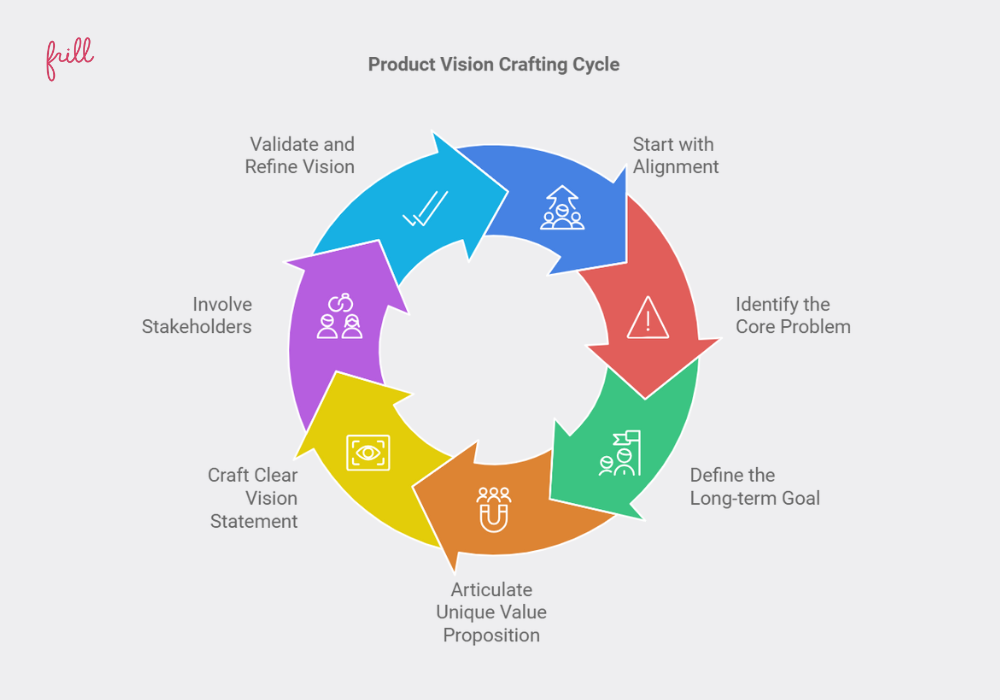Crafting a Clear Product Vision for Success
Last updated on Tue Oct 15 2024
The success of a product is often attributed to several factors, like features or effective marketing. However, the initial vision lays the foundation. Before the product is developed, its success begins with an inspiring product vision. In our current business climate, you must craft a product vision. And here’s why.
A study revealed that over 95% of new products fail, a staggering number that gives room for pause. Most of these failed products have no product vision or are ineffective. Like a seed, product vision determines the flourishing of the product. It trickles into team motivation and is a catalyst that produces changes. It also focuses on the user, implementing their suggestions.
Read on for more.
What Is a Product Vision?
How do you want your product to be? What problem do you want to solve? These questions and more frame a product vision. A product vision serves to define both the purpose of a product and its mission. Written in a simple and clear statement, it is the “x” mark on your product development map. Think of it as the destination of your entire development journey, providing a sense of direction.
The product vision acts as a communicative medium both for the team and external audience. For the team, a vision provides a sense of direction. For the external audience (users, investors…), a vision showcases the product’s value. All decisions surrounding product development are guided by the product vision. It also encourages innovations and enhances user experience.
Why Is Product Vision Important?

Product vision is vital to a product’s success, just like all projects depend on a clear vision. Below are specific reasons for its importance:
1. Enhances Productivity
The sense of direction a product vision provides is a catalyst for productivity. The team can channel their energy, resources, and efforts when they have a clear understanding of their destination, leading to more productivity. Additionally, a good vision avoids shadowboxing and other distractions.
2. Encourages Stakeholders to Support
A product vision is equally inspiring for stakeholders. Given the choice between two projects, every stakeholder would go for one with security. Your vision offers stakeholders that security. When secure, it is easier to gain their support, particularly if the product has a high chance of success. People also love to collaborate on a project that makes a difference. When your product vision assures stakeholders of the long-term benefit to society, it forms strong partnerships.
3. Ensures That the Focus is on Users
An impactful product is user-centered, seeking to satisfy user needs and offer solutions to their problems. A strong product vision reminds developers of user needs and shapes their priorities. Through their opinions and suggestions, users also become partners in developing the product.
4. Guides Decision Making
Numerous choices must be made in the product development process. The product vision aids with setting priorities and streamlining the decision-making process. A strong product vision addresses many facets of product development, from feature prioritization to resource allocation.
5. Encourages Cooperation
Teams come together with a product vision that keeps everyone in the same direction. When the vision is spelled out, each department understands the ultimate destination and its role as complex parts of a whole. The teams also remain motivated thanks to the clarity they have.
How to Craft a Compelling Product Vision

Step-by-step. Systemic. A product vision is most effective when it follows a process, moving from one point to another. The vision itself may seem simple and small, yet it must not be taken lightly. Here is a process you can follow:
Step 1: Start with Alignment
Before taking a step into crafting the product vision, ensure that everyone on your team is on board. Product development is collaborative work between the leader and the team, beginning with the vision. Even more, team members turn to committed partners when they participate in the formulation of the vision. All individuals should be on board with the product’s purpose and its importance to the larger population.
To encourage the contribution of team members, set an atmosphere that allows for their input. Have brainstorming sessions or workshops where feedback is emphasized. This internal alignment creates a shared understanding of the product, which equals a vision borne out of consensus.
Step 2: Identify the Core Problem or Need
The next step is to define the problem that your product sets out to solve. What are the issues out there? And what is the solution you wish to provide? This is not an abstract exercise, by the way. The problem should stem from users, not your imagination. Real-time issues lead to identifying deeper problems, as opposed to superficial ones. With UX research tools such as UXtweak, you can conduct live interviews with your users and get a better idea of their needs.
A crucial tool to define the problem is user feedback, which is obtained using different means like surveys and interviews. User feedback keeps the spotlight on the users, resulting in a product vision that meets user needs.
Step 3: Define the Long-term Goal
The product vision covers your long-term goal, being both ambitious and achievable. Like every good goal, it should also be specific, not vague, allowing for measurements.
The SMART criteria is the most common tool. It requires that the goal be Smart, Measurable, Achievable, Realistic, and Time-bound. There are other techniques available as well, such as the HARD goals (Heartfelt, Animated, Required, Difficult) and the GROW model (Goal, Reality, Options, Way Forward). Look into the best model for you.
In the end, the long-term goal should be sufficiently compelling, obvious, and understood by the team.
Step 4: Articulate the Unique Value Proposition
What sets your product apart from competitors is captured in your unique value proposition (UVP). Other brands have developed something similar. What makes yours different from the rest? The UVP ensures your product does not disappear within the pile of similar products with the same features. UVP is one factor that separates Netflix from Amazon Prime, or a Samsung device from an iPhone. It should be concise, simple, and always within reach.
The UVP’s focus revolves around the product’s benefits, the pain points of users, and why customers should gain. Ensure the distinctions are clear. Your UVP must show how your product differs from competing ones without exaggerations.
Step 5: Craft a Clear and Concise Vision Statement
After the preceding four steps, craft your vision statement. Jargon and complicated language must be avoided to make it straightforward and succinct. Instead, speak in plain English, that non-developers can understand. Simple language communicates more effectively, drawing everyone closer. The vision statement should also be memorable, sticking to the reader’s memory.
Your first vision statement may be long as you try to frame your words. Do not worry about it. The initial draft serves to lay down your ideas. Thereafter, aim at conciseness, reformulating the lengthy words into a shorter form that still captures the essence.
Step 6: Involve Stakeholders
The product vision also includes the expectations of stakeholders. As stated in the importance, stakeholders develop confidence in the product that offers a compelling product vision. That being the case, always keep them in mind. Stakeholders include investors, partners, and even customers. They are a part of the product’s success and must be treated as such.
Involve stakeholders in practical ways, like interviews or sharing drafts of the vision for feedback. Encourage their active participation right at the onset to keep them in the loop throughout the development process.
Step 7: Validate and Refine the Vision
You have crafted your vision, but does it resonate with users? That is the question this step tackles. Users should agree with the vision and its potential utility for them. If your product meets its pain point, users will acknowledge this in the validation process. Feedback is as important here as in other steps, so actively collect them. The result of your feedback enables you to shape your vision to the users. After all, what good is your vision if it does not meet user needs?
Also, validation is not a one-time process. It extends even beyond the product’s launch, and informs further updates.
Best Practices in Crafting a Compelling Product Vision
After crafting the product vision, it needs to maintain its relevance over time. The product vision is crafted for practical use, and here are some practices to implement:
1. Visualize and Communicate
Product visions remain abstract until it is visualized, painting a concrete picture in the minds of stakeholders and team members. Visualization aids in communication and proper understanding. What visualization essentially means is this: Portray what the finished product looks like, including the mission and target audience.
2. Keep a Detailed Roadmap
The product roadmap complements the product vision, adding more details. While the product vision provides a picture of the destination, the roadmap structures the road to the destination. Gain more on our creating your product roadmap.
3. Continual Alignment
As the world evolves and the market becomes more competitive, your product vision must also be flexible. Monitor market trends and customer demands, then act accordingly.
Conclusion
Crafting your product vision is important, but the same vision must be brought to reality. The foundation must be built upon through constant planning. The steps and practices above serve as a guide for both formulating and setting in motion the product vision.
Shape the steps to fit your preference, and use the practices as a springboard. At the end, your goal is to bring a product your users will enjoy.